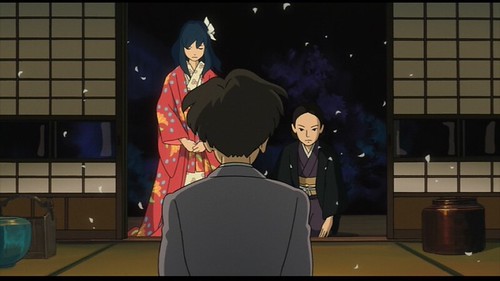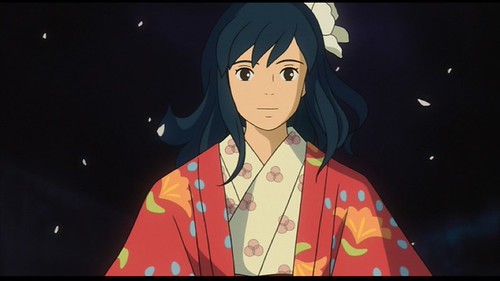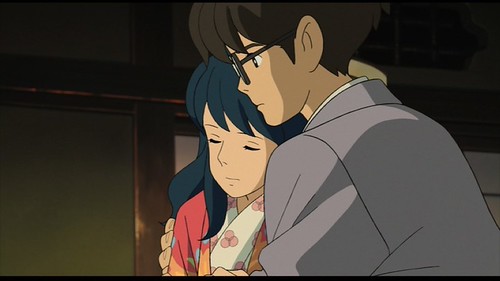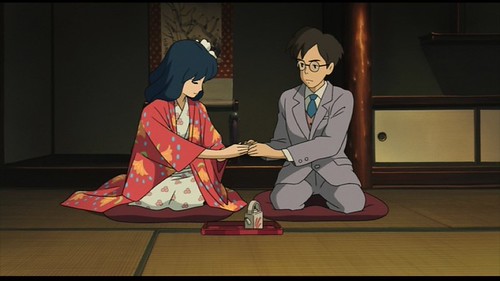I’m considering writing a weekly post in which I ramble over what I’ve been up to in the past week and perhaps think about the week to come. That’s what I’m doing now. Maybe I’ll make it a regular activity, maybe not. We’ll see.
The screen shots in this post are from the marriage sequence in The Wind Rises.
Daily Routine
First, my daily routine isn’t so stable as it’s once been. On those days when I have two shots of scotch I tend to have them earlier in the day than my usual, which has been after 4 or 5 PM. These days I may have my scotch as early as 1 PM, but more likely 2 or 3 PM. But still, only two, and not every day.
What’s up with that?
I’ve always been a napper, two or three a day, morning and afternoon. These days at least once or twice a week I may sleep 45 minutes to over an hour in the early evening, which is more than a nap, but then I’ll work to 10:30, 11 or even midnight or later. That’s unusual.
Miyazaki
This morning, for the first time in over two years, I spent time taking screen shots of a film, Miyazaki’s The Wind Rises. (Why the hiatus? Changed computers and my screen shot software no longer worked.) This is something I like doing. It’s a way of thinking about a film, of observing what goes on. I don’t see how any serious student of film can work without being able to view scenes over and over and to stop the film and take frame grabs.
Anyhow, I took two dozen shots of the opening sequence and I’ll be doing a post on it, maybe later today, maybe not ‘till tomorrow or later. Just as Walter Murch’s opening montage for Apocalypse Now prefigured the whole film and set us up for it, so Miyzaki’s sequence prefigures The Wind Rises. The end is there in the beginning. The sequence also echos Porco Rosso and Howl’s Moving Castle.
If you come to the film knowing that it’s about the aeronautical engineer who designed the (in)famous Zero of World War II, you know that the film will sooner or later arrive at that war. But why does Miyazaki prefigure it in an opening dream sequence? – for that’s what it is, though we’re well into it before we realize that it’s a dream? This, of course, is an aesthetic decision, as is the decision to end in a dream where Horikoshi’s dead wife urges him to live.
In between, the life – college, earthquake, taking a job with Mitsubishi, a trip to Germany to observe their aeronautical engineering, vacation in the mountains, falling in love, designing and testing a new plane, success, wife dies, World War II – it’s all there, interspersed with dream sequences where he chats with a childhood hero, Gianni Caproni, the Italian aeronautical engineer. What aesthetic function, what ethical function, do these dream sequences serve? Why Italy? Yes, it’s European, on the opposite side of the world from Japan. What else is bound up in that opposition?
Dream-Italy-pure flight vs. WakingWorld-Japan-War
What holds them together? Does it go like this?
Gianni Caproni || Horikoshi's Wife
Why Jiro Hirokoshi? Yes, he’s an aeronautical engineer and Miyazaki’s family was in the airplane business. But, as a designer, and engineer, Horikoshi created things: something from nothing. That, of course, is what Miyazaki does.
Description and Computing
I continue to be astounded that literary critics have so little interest in literary form. Oh, yes, they may natter on about form in all sorts of ways, but they don’t give it much concrete attention, they don’t describe it. Why not?
Is it simply that it’s so elusive? There’s more going on than that. Surely it’s that they can’t get past this preoccupation with meaning. As tricky as it is, it’s easier to grasp at that form.
What a waste!
Meanwhile I’ve begun articulating a useful connection between computation and diagrams. Namely that the diagrams we want for describing the formal features of texts are also diagrams that have useful computational properties. So, a literary critic who is at best indifferent to computation can nonetheless absorb a computational perspective by diagramming literary forms.
As for computation, I fear it will be a tough sell. Though not for ideological reasons, those I suspect are just rationalizations. The real problem is that working with it requires a distinct mode of thought. And so many humanists just don’t what to go there? I need to think about that. What’s the umbilicus that ties literary critics to prose? Why are they lost without it?
As long as they think of computation as arithmetic and as whatever is done by, you know, computers, they’ll never get there. I wonder if David Deutsch will help? He’s a physicist working in quantum computing. In particular he’s conceptualizing computation as a kind of very fundamental physical process. I think that’s what we need. Alas, the technical papers are beyond me and the informal expositions don’t quite get me THERE, wherever that is. But that’s what I want in thinking about a literary text as the trace of a computational process. That makes the text’s form the form of a physical process.
Information, of course, is the other side of computation. Deutsch talks of information as “the thing that has remained unchanged throughout [some physical] process” and I understand that. But, in the case of literary texts, what’s the process? Is it the reading of the text? Not quite. Rather, I think it’s the sharing of the text within a group. What remains unchanged (between individuals) in that process? That’s what we want to understand.
And we’re NOT going to understand it by saying that the author puts meaning into the text which the rest of us are then obligated to extract from the text. If that’s are starting point, then we can’t get there from here.
Joseph Carroll and Friends
And that brings me to Joseph Carroll, the most dangerous literary critic on the planet. But insisting on the traditional view, that authors put meaning into texts and the critic’s job is somehow to extract it, he makes it impossible to conceptualize literary process in a 21st century manner that would allow us to understand how literary texts can be so central to social functioning. By insisting on an old way of thinking about the problem – authorial intention – he blocks the way to investigating a new approach, one based on an understanding of cultural evolutionary processes. It’s in the circulation of texts within groups that the invariant “meaning” emerges, though not in the form of explicit verbal discourse.
But that’s a larger argument than I can undertake in this post. Much larger.
What struck me last week was simply the outright nonsense of his assertion that early work in cognitive science “operated in the discursive mode of formalistic speculative philosophy” – that was the starting point for last week’s post. I’ve been following his work for a long time and so I knew that he didn’t know much about cognitive science in general and that, in particular, he knows little or nothing about computational views of the mind – a characteristic widely distributed among literary critics, alas. That’s one thing.
But the extravagant inaccuracy of that statement, that’s something else. It’s unnecessary and inexcusable. Even if he doesn’t understand computing and cognitive science, why couldn’t he bother to get the history right? And yet there it is on page 167 of a book that Carroll published in 2012, Graphing Jane Austen. What’s up?
Of course, he didn’t publish that book by himself. He had three co-authors, Jonathan Gottschall, another literary critic, along with John Johnson and Daniel Kruger, both psychologists. I don’t know what there internal working arrangements were, but the psychologists would have been responsible for conducting the survey and analyzing the data. I’m guessing that Carroll drafted that bit of prose; the project was his project and he’s the one who carries the burden of conceptualizing the position of literary Darwinism in the intellectual world. But, if he drafted it, the rest must have signed off on it.
Why? Didn’t ANY of them know better?
But, there’s a sense in which Joseph Carroll isn’t merely an individual scholar. He’s the recognized leader of a critical school he initiated two decades ago with the publication of Evolution and Literary Theory. He’s been developing his ideas in the context of scholarly discussion and debate. Some thinkers approve his line of thought; some are violently opposed, while others are somewhere else. That ignorant dismissal of cognitive science is a small move in that discussion and debate.
What’s it expressing? Carroll and his colleagues are used to arguing against humanists who are skeptical about biology, who may actually fear and be disgusted by it. But there are also many humanists who feel the same way about computing and computers. I’m now wondering of Carroll is among those. It’s one thing to be ignorant about cognitive science. It’s quite something else to fear it because of its connection with computing.
Is that what’s behind that statement – and behind the conceptual inadequacies Steven Pinker diagnosed in his review of The Literary Animal (and that I discussed in last week’s post)? Is Carroll ignorant of computing because he fears it? I don’t know.





No comments:
Post a Comment